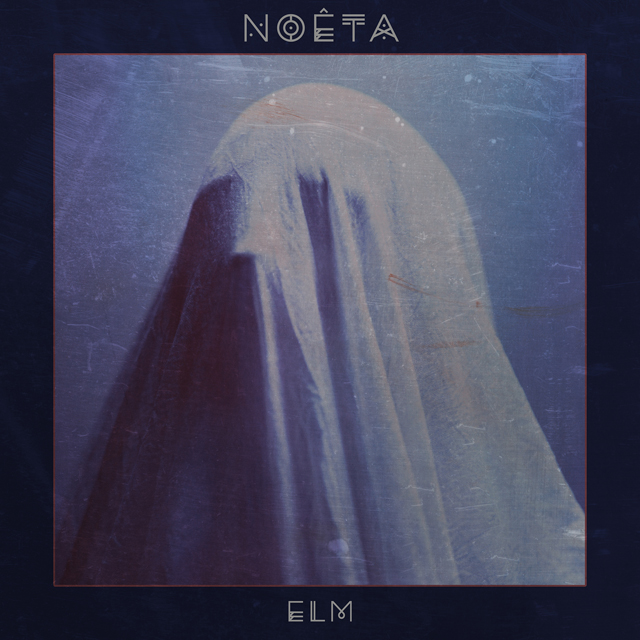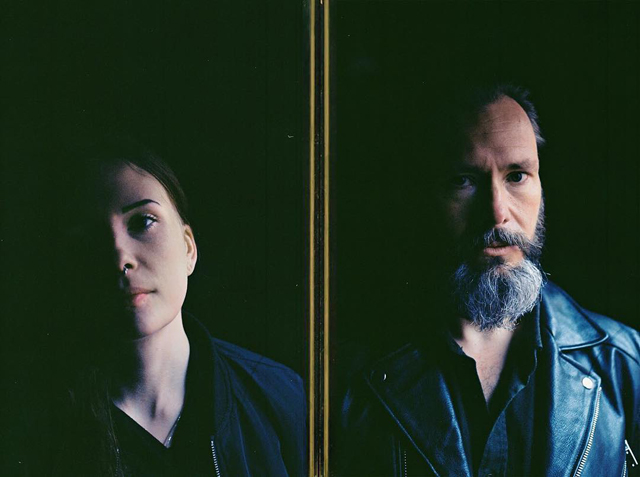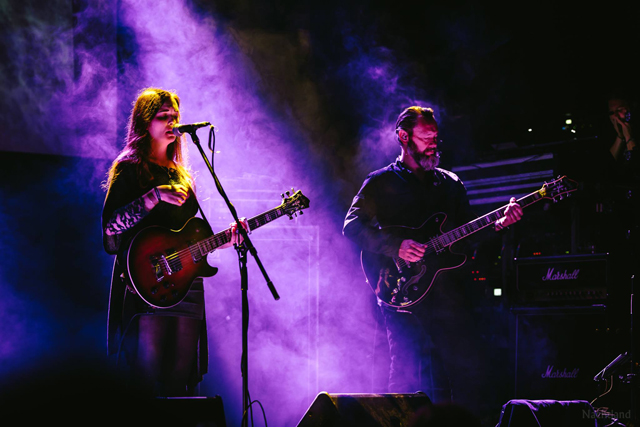
We all look for something in music, whether it is an escape, relaxation, or an exhilarating and uplifting effect – music is different things to different people at different points in time. The artform’s relevance is fluid and changes constantly – from morning to evening, from day to day, year to year. Whatever each of us is looking for in music, it is certain that a special piece can make a difference in a person’s life.
One such special piece of music, something you don’t encounter every day is the album Elm by dark ambient duo Noêta. Norway-based vocalist Êlea and her long-time collaborator Ândris from Sweden have created an album that invites introspection by mimicking the flow of nature, of air and water. Elm has nothing in common with the generic tunes available via meditation apps. Loosely-based on a poem by Sylvia Plath, the album’s acoustic soundscapes capture the beauty of nature, but they simultaneously manage to include the inherent darkness, especially the dark undercurrents of the human psyche. Creating music that defies categorization, Noêta have charted their very own left-hand path.
Mesmerized by Elm, I appreciated being given the opportunity to put together some questions for the artists to answer.
AN: How did Noêta come to be? What was the motivation, the aim behind the project? What were/are its premises? What were the musical paths that led to it?
Êlea: NOÊTA came to be in late 2013, when me and Ândris worked together for a short amount of time. We kept in touch and wrote the songs that became our EP psykhē. In the beginning our creative process was a reaction towards the regurgitated music we were exposed to, thus we wanted to explore unconventional song structures, production methods and themes. We recorded with analog gear and still to this day we have an approach where we record and produce most of the music at home ourselves. It has always been a lot about emotions, for me as an exploration of my own psyche, but as a whole, the music was thought to be an accompaniment to introspection. NOÊTA has always been a lot about the process of sonic exploration, where we’ve aimed to weave many musical expressions into one.

AN: The spirit of nature is omnipresent in your music: Nature’s beauty, its delicacy, its mystery and its dangers. I imagine you spend a lot of time outside, observing and listening. Where do you live? Where did you grow up? How do your surroundings influence your music?
Êlea: The idea is, in a lot of ways, that nature is not a thing separate from us humans. It’s as much part of us, as our music. To that point, we’ve explored both the “beautiful and sublime”
aspect of the natural world in NOÊTA. I spend hours outside every day, and Ândris also spends a lot of time in nature, since childhood, he’s had a great fascination with birds. He
lives on an island in the archipelago outside Gothenburg, where the nature is rough and barren. I grew up in the southern part of Sweden, by the west coast, where it’s quite flat and
undramatic. I’ve always, since I was a child, needed to ascend things, and I love to climb. I think that freeing feeling, almost cathartic, is something I try to channel into our music as
well. I searched for a place to live where the nature was more dramatic than my home town, which led me to spend a few years in Canada, and now I live in Norway.
AN: Which artistic tradition do you consider yourself part of? Dark folk and atmospheric black metal have a lot in common with themes, ideas and artists form the Romantic era. There is the same emphasis on emotion. Nature and its effect on the individual are explored, just as the Romantics did, by spending time alone in nature, by distancing oneself from the world of humans. Are artists who express themselves in the genres above the new Romantics?
Êlea: That’s a very difficult question to answer. I wouldn’t really say that we have a clear feeling of belonging to one tradition, as we have taken influence so broadly, both in a direct (musical) way, as well as a more abstract (thematic) kind of way. We’ve discussed and read everything from Baudelaire, to Sylvia Plath, to Norse cosmology, and visually we enjoy art from romantics as well as expressionists among many. The latter would probably be what we relate to the most. I do think Knut Hamsun described it very well, when speaking of his novel “Hunger”; “It is an attempt to portray the strange and peculiar inner life”.

AN: Given the music of Elm and its inspirational source, the album’s cover seems quite unusual. One would have expected, say, a photograph of dew-heavy flowers, moss and damp earth. Instead, there is a picture of a shrouded figure. What’s the idea behind the cover? Why did you choose it?
Êlea: That’s an interesting take, I do not think of dew-heavy flowers or moss when I read Sylvia Plath’s poetry. The cover is supposed to be a manifestation of our shadow self, the darkness that lies beneath the constructed version of ourselves that we show to the world. Those demons that hunt Sylvia Plath in the poem “Elm”, and what she calls the malignity.
AN: Your vocal performance is of an aethereal, soft, tender nature; the lyrics, likewise, appear vague and seem to have a stream-of consciousness character. What are the subjects your lyrics comment on/deal with?
Êlea: The lyrics on this release became a compromise with myself. I was in a place where I found it hard to write what I wanted to portray with the songs, so I put my focus towards the singing and the flow of the melodies over the lyrics. That’s probably why they have the “stream of consciousness” feeling that you describe. As a whole, the album, lyrically, draws a lot of parallels to “Elm ” and my above description of the cover; it’s about the darkest parts of ourselves, the unrest, the anxiety, the dissonance. I wanted the style of singing to contrast
the subject matter in a way, it being ethereal and soft, while thematically it’s quite dark.
AN: Sylvia Plath is no light reading and reading poetry, in general, not exactly a wide-spread habit today. How did you come across Sylvia Plath and why did you name your album after her poem “Elm”?
Êlea: This wasn’t a conscious idea to begin with. We had written much of the album already when Sylvia Plath was introduced. I was working on the outro song, and felt uninspired to write, so I wanted to use a poem to portray those feelings in words that weren’t mine. Ândris laid out a few poems that he thought suited what I was after and from them I picked “Elm”. I think both me and Ândris have an interest for literature in all shapes and forms and it’s bound our collaboration together through the years as well.

AN: Besides Sylvia Plath, are there other poets whose works provide solace or serve as a source of inspiration?
Êlea: Yes absolutely, works like; “Smärtans mönster” & “Daphne” by Rut Hillarp, “I am alive — I guess” by Emily Dickinson, “O make me a mask and a wall… ” – Thomas Dylan and “Châtiment de l’Orgueil” by Charles Baudelaire are all poems I, or we both come back to. Ândris reads Swedish poetry from different generations, like Erik Lindegren, Ann Jäderlund, Matilda Södergran and Johan Jönsson.
AN: Your music invites an introspective process, I find. Can one spend too much time in introspection? Or is one of today’s widespread problems rather the lack of introspection because of abundantly available distraction?
Êlea: I think that prompts an even bigger philosophical question. Some say that the only true life is the one in our heads, that everything else is constructed parts of society. I think there’s a downside to spending too much time in introspection, in the sense that it can almost consume you and your focus entirely, which isn’t very practical unless you’ve decided to live out your days as a hermit. In the same way I think not spending enough time in reflection and quiet solitude makes for a very fleeting existence. Distractions being, as you say, abundantly available these days, is to me a very dangerous thing. It plays on all the shortcomings of the human psyche, like the need for connection and confirmation by others, to the point where you may lose yourself in the process or repress what you really feel because it’s the easier thing to do and the gratification more instant.
AN: What does your song-writing process look like? How do you compose music that evokes pictures of running rivers, velvety evenings and dewy mornings?
Êlea: The process varies a lot between the songs. In that, there is also the fact that some songs are instigated by Ândris and some by me. Often it starts with an idea, like wanting to capture a feeling or an image, or maybe it starts with a guitar riff that we like. We will then build on that, usually by taking turns working on the song in different ways. We share the project files and more often than not, sit alone in our own homes, working on it before passing it back. This way we often create a lot of the soundscape transferred into the mixing process, already during song-writing. When we are getting closer to finalizing a song, we will meet up and mold the parts into a flow, and make decisions on the final mix etc. By this point I’ve already laid out some temporary vocals, to see if we need to change some of the musical components to work better with the singing.

AN: What does the future hold for Noêta? Once the pandemic is under control, are you planning to play shows, go on tour? Where would you like to play? What would be the ideal set up for your show?
Êlea: It’s very uncertain at this point, as we have no immediate plans. Touring has always been difficult for us because we live quite far apart, and practising is logistically difficult. We’ve only played three shows, mostly because on the album recordings, we play so many instruments and have so many vocal tracks, that it’s hard to realize that without relying heavily on backing tracks, and we didn’t find that to be too successful. We’ve discussed finding session musicians for shows in the future, and if we do play live, I’m thinking that would be the ideal set up. This, in addition to having a live setting that compliments our music would be ideal, like a dark and intimate venue for example.
AN: Some musicians are so absorbed in creating their own music they hardly listen to new releases. Is that true for you, too? Are there any currently active artists that you like and follow?
Êlea: I can only speak for myself, but I’m quite a music fanatic. I listen to a lot of different genres and even though it may take me a while to catch up on new releases, I always do if it seems interesting. This is also the case for old releases I haven’t had the chance to look into yet, as those are still many. Though I do find that while writing an album, especially as the songs start to take form, it’s harder to disconnect from that process and indulge in other musical works. I think it’s going to be much too long of a list to mention all the artists I like, as it varies from everything from black metal, folk, classical, ambient to pop and so on.
(Interview Slavica)
02/06/2021 at 4:49 am
Great interview with a great musical project! Thanks!